Fields: Catalog options
Path: Catalog > Service Template Management > New/Edit > Resources > Add field
Path: Catalog > New Service Template > Resources > Add field
The "Catalog options" section of the Resources tab lets you add custom fields to your service template. You can add one of several field types. (The options and associated fields change depending on the field type you select.)
Standard fields
These three fields are standard in every new field you add:
Field type
Lets you specify which type of field you want to add to your service template. You can choose from the following options:
Label
Lets you specify the descriptive label (or name) of the field. What you specify in this field is what the user will see in the form.
This field is not required.
ID
Lets you specify the unique identifier for the field. The value you specify should correspond to one of the following:
- One of the keyword values recognized by Moab Web Services (for details, see "ID" field keywords).
- A Moab generic resource value (for details, see "Managing Consumable Generic Resources" in the Moab Workload Manager Administrator Guide.)
- A Moab variable value
If the value you specify in the ID field does not match one of the Moab Web Services keywords and you select the Schedulable resource option, Viewpoint assumes the field is a Moab generic resource. Otherwise, Viewpoint assumes the ID value is a variable.
If you want to specify a generic resource ID, the ID field value must match the exact name of the generic resource configured in Moab. (See "Managing Consumable Generic Resources" in the Moab Workload Manager Administrator Guide for more information on generic resource configuration.)
The ID value must be unique for every new field you add.
Additional options
Some fields have the one or more of the following additional options:
Lets you specify whether or not the user will be allowed to modify the specifications of the resource.
If you select this option, you must be sure you specify a default value. Failing to do this will leave a blank field that the user will not be able to do anything with.
Schedulable resource
Lets you specify whether the field represents a schedulable resource. When a field is marked as a schedulable resource, its value must be an integer. If you do not select this option, Viewpoint assumes the field is a variable, and its value can be non-numeric.
The Schedulable resource option is, in essence, an attribute that allows you to define the type of data being written. For example, if you select Schedulable resource when defining a text field with the ID set to "bob" and the Value set to "5", then the service request would have an "attributes" section like this (with the "bob" key-value pair written to the resources object in the service request):
attributes: {
moab: {
job: {
resources: {
bob: "5"
},
variables: {
}
}
}
}
If you left the Schedulable resources option unchecked, then the same input field would be interpreted as a variable (written in the variable object):
attributes: {
moab: {
job: {
resources: {
},
variables: {
bob: "5"
}
}
}
}
Visible to user
Lets you specify whether or not the field will appear in the user service template form.
When you select this option, the Editable by user option will automatically clear. (If a user cannot see the field, they cannot edit it.)
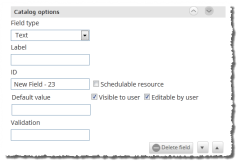
|
|
Click to enlarge |
Creates a field in which a user can specify any string data. For example:

Default value
Lets you specify a value that will be pre-populated in the field when the user opens the form.
If you have not selected the Editable by user option (meaning the user cannot edit the field), then the default value will be the only option for the user. If you want the user to be able to choose from more than the default value, make sure you select the Editable by user option.
Validation
Lets you specify a regular expression (using JavaScript regex syntax) that will check and validate the user input on this field.
This validation causes Viewpoint to notify users when they enter something invalid in the field. (For information about regular expressions, please see http://www.regular-expressions.info/.)
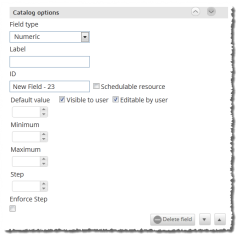
|
|
Click to enlarge |
Creates a number spinner in which a user inputs numeric data. For example:

Default value
Lets you specify a number value that will be pre-populated in the field when the user opens the form.
You must make sure that the Default value is greater than or equal to the Minimum value and less than or equal to the Maximum value.
If you have not selected the Editable by user option (meaning the user cannot edit the field), then the default value will be the only option for the user. If you want the user to be able to choose from more than the default value, make sure you select the Editable by user option.
Lets you specify the minimum value that will appear in the number spinner. In other words, it lets you specify the smallest number that the user may request of the resource.
Lets you specify the maximum value that will appear in the number spinner. In other word, it lets you specify the largest number that the user may request of the resource.
Lets you specify a number interval that the number spinner uses to move up or down. For example, if you specify "10," the number spinner will move up or down by ten integers each time the user clicks up or down.
Enforce Step
Lets you enforce that the users cannot specify a number value (by typing it in) that does not conform to the Step settings you specify.
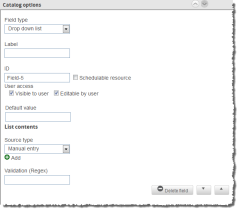
|
|
Click to enlarge |
Creates a list field in which the user may choose from one or more predefined options. For example:

Default value
Lets you specify the default number value that will be pre-populated in the field when the user opens the form.
Make sure that the default value is an actual option in the List Contents field.
Source type
Lets you choose the method by which the drop-down list labels and values will be generated. If you choose Manual entry, you must specify possible values for the field. The drop-down list displays the items you specify in this field. The content you provide for this field is simply a predetermined value (as in a key-value pair).
To add a new option, specify a value in the Item field and choose Add list item. To remove an item, click Remove next to the list item you want to remove.
This field must have at least one item in order to create the service template.
If you choose the Dynamic loading Source type, use the Source (URL) field to specify the URL that will generate the drop-down list using JSON. The URL should return something similar to this:
[
{"name": "Option 1",
"value": "Option1"
},
...
]
The drop-down contains an item called Option1 that appears to users as Option 1 in the list.
Validation
Lets you specify a regular expression (using JavaScript regex syntax) that will check and validate the user input on this field.
This validation causes Viewpoint to notify users when they enter something invalid in the field. (For information about regular expressions, please see http://www.regular-expressions.info/.)
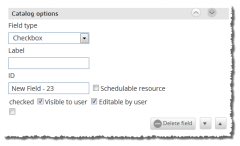
|
|
Click to enlarge |
Creates a checkbox that the user clicks to indicate that a value is true. For example:

Checked
Lets you specify if you want the checkbox selected by default.
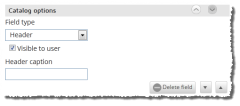
|
|
Click to enlarge |
Creates a display-only, organizational header to categorize fields and set them apart from others. For example:

Because this field is for display only, there is no Label field or ID field associated with it.
Header caption
Lets you specify the text that will appear in a field group heading.

|
|
Click to enlarge |
Creates a custom field that you configure with HTML, JavaScript, etc.
Open text
Lets you specify HTML, JavaScript, etc. for a custom field.
You must take special care when using the Open field, because the code you provide can be executed by the end user.
In the case that you use JavaScript, it is recommended that you use jQuery. However, there are two things that you should be aware of:
- Where you would normally use the jQuery(document).ready() function, you will need to instead use an onTemplateLoad function, in this manner:
- If you want to use a jQuery selector in the form of jQuery("#id"), you will need to instead use a findLocally function in the form of findLocally("id", currentTemplate).
onTemplateLoad (function(event, currentTemplate) {
// code
});
The reason for this is that Viewpoint will cause the ID to be unique (alter it) across all the templates on the form.
For example, if you were to construct an input with the ID of "alpha" and then turn it into a number-spinner input, normally you would use the following JavaScript:
<input id="alpha" name="alpha" />
<script type="text/javascript">
jQuery(document).ready(function() {
jQuery("#alpha").spinner();
});
</script>
However, to have this same functionality in a Viewpoint Open field, you should use the onTemplateLoad and findLocally methods, as follows:
<input id="alpha" name="alpha"/>
<script type="text/javascript">
onTemplateLoad(function(event,currentTemplate){
findLocally("alpha", currentTemplate).spinner();
});
</script>
Here is a list of some things you can do with the Open field:
-
You can use a script to send field values to a web service for validation. Here is a generic example of what this script would look like (with the returned JSON).
- If you want to create an input that is not saved to the service (such as filtering lists or radio buttons that toggle other sections), add the noSave class to the input. Inputs containing the noSave class are not sent to the service generation system as a variable or resource. For example:
- If you want an open field to be a schedulable resource, you can set the isresource attribute to "true". For example:
- If you want to create an input that saves custom data to a service request (for example, because you wanted a web service plug in to find the data and execute additional actions), you can set the shareddata attribute in the input to "true". For example:
<label>Input A</label>
<input id="alpha" name="alpha" class="required"/>
<br clear="all" />
<label>Input B</label>
<input id="beta" name="beta" class="required" />
<script type="text/javascript">
onTemplateLoad(function(event,currentTemplate){
var nodeA = findLocally("alpha", currentTemplate);
var nodeB = findLocally("beta", currentTemplate);
var updateValidation = function(){
jQuery.ajax({
type : "GET",
url : "/moab/serviceTemplate/validateInput",
data :{ nodeA: nodeA.val(), nodeB: nodeB.val() },
contentType : "application/json; charset=utf-8",
async: false,
error : function(xhr, status, error) {
nodeA.rules("add",{required:true});
nodeA.rules("add",{regex:"$^"});
nodeB.rules("add",{required:true});
nodeB.rules("add",{regex:"$^"});
},
success : function(responseStr) {
var response = eval("(" + responseStr + ")");
if (response.result){
nodeA.rules("remove"); nodeB.rules("remove");
}
else {
var validationConfig = {
regex:"$^",
messages:{ regex: response.message }
}
nodeA.rules("add",{required:true});
nodeA.rules("add", validationConfig);
nodeB.rules("add",{required:true});
nodeB.rules("add",validationConfig);
}
}
});
}
nodeA.change(updateValidation);
nodeB.change(updateValidation);
});
</script>
//Example JSON to send to web service
{
nodeA : "<value>",
nodeB : "<value>"
}
// Example JSON response from web service
{
success : false,
message : "<message>"
}
<input ID='myInput' class='noSave'>
<input id='bob' value='5' isresource='true' />
This input would result in a service request like the following:
attributes: {
moab: {
job: {
resources: {
bob: "5"
},
variables: {
}
}
}
}
<input ID='bob' value='5' shareddata='true' />
This input would result in a service request like the following:
attributes: {
moab: {
job: {
resources: {
},
variables: {
}
}
},
sharedData: {
bob: "5"
}
}
You can also pass JSON objects via the input field. For example:
<input ID='bob' value='{"hello":"there"}' shareddata='true' />
This input would result in a service request like the following:
attributes: {
moab: {
job: {
resources: {
},
variables: {
}
}
},
sharedData: {
bob: {
hello: "there"
}
}
}
The ID values you specify must be unique from other field ID values, including those in the Required resources section of the template form.
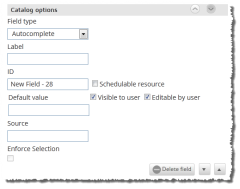
|
|
Click to enlarge |
Creates a text box in which the user begins typing and suggestions appear beneath the box. The user clicks, or uses the arrow keys to navigate to, a pre-determined suggestion to insert into the field. For example:
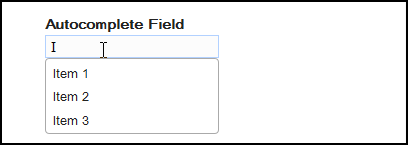
Default value
Lets you specify a value that will be pre-populated in the field when the user opens the form.
If you have not selected the Editable by user option (meaning the user cannot edit the field), then the default value will be the only option for the user. If you want the user to be able to choose from more than the default value, make sure you select the Editable by user option.
Source
Lets you specify the JSON array that determines the autocomplete field suggestions. You can specify the JSON array in one of two ways:
- Manually enter the JSON array.
- Specify a web service URL that returns a JSON array. To filter the list, you must configure the server script at the specified URL to accept a parameter called "term." The parameter filters out the autocomplete terms as the server side script mandates.
The JSON array (whether entered manually or returned from a web service URL) should consist of a series of objects, each of which has a "label and "value" entry. For example:
[
{"label":"1","value":"1"},
{"label":"2","value":"2"},
{"label":"2a","value":"2a"}
{"label":"2b","value":"2b"},
{"label":"2c","value":"2c"},
{"label":"3","value":"3"},
{"label":"31","value":"31"}
]
Enforce Selection
Specifies that you want to ensure the user input matches one of your suggested values. In other words, when you check this option, the user will not be allowed to submit a value that is different than one of your suggested values.
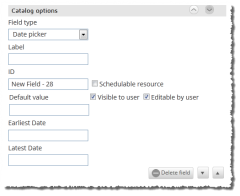
|
|
Click to enlarge |
Creates a field in which the user specifies a date value by navigating to the date in a pop-up calendar and selecting it. For example:
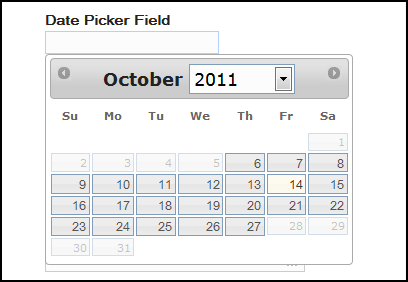
Default value
Lets you specify the date that appears in the field by default. You select the date from a pop-up calendar.
You must make sure that the Default value is before or equal to the Latest Date value and after or equal to the Earliest Date value.
If you have not selected the Editable by user option (meaning the user cannot edit the field), then the default value will be the only option for the user. If you want the user to be able to choose from more than the default value, make sure you select the Editable by user option.
Lets you specify the earliest date possible the user can select. You select the date from a pop-up calendar.
Lets you specify the latest date possible the user can select. You select the date from a pop-up calendar.
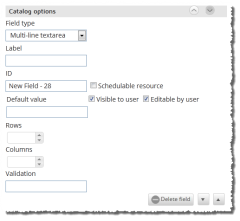
|
|
Click to enlarge |
Creates a custom-sized field in which the user can input any string data. For example:
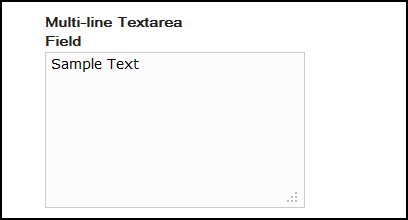
Default value
Lets you specify a value that will be pre-populated in the field when the user opens the form.
If you have not selected the Editable by user option (meaning the user cannot edit the field), then the default value will be the only option for the user. If you want the user to be able to choose from more than the default value, make sure you select the Editable by user option.
Rows
Lets you specify the number of rows the multi-line text field will have.
Columns
Lets you specify the number or columns the multi-line text field will have.
Validation
Lets you specify a regular expression (using JavaScript regex syntax) that will check and validate the user input on this field.
This validation causes Viewpoint to notify users when they enter something invalid in the field. (For information about regular expressions, please see http://www.regular-expressions.info/.)

|
|
Click to enlarge |
Creates an autocomplete field in which you can specify multiple values.
Default tags
Lets you specify any default tags that you want to appear in the user form.
These values can be tied to a JSON array if you specify a valid Source.
Press Enter to add an entry. You can add multiple tags.

Lets you insert a JSON array or the URL of a service that returns a JSON array list. To filter the list, you must configure the server script at the specified URL to accept a parameter called "Term."
Enforce selection
Lets you specify whether users can submit values that are not contained in the list. When checked, Viewpoint will return an error when a user attempts to submit the form with a custom value specified in this field.
Related topics